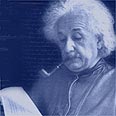
HAIFA - The beginning of my visit to the Israel National Museum of Science in Haifa was no indication of what I was about to experience.
As I entered the 100-year-old building, I was greeted by rounded windows, chiseled stone walls, and wooden doors.
After a few short moments of snooping around, I found myself in a dark room, and the door closed silently behind me. I managed to make out rows of red cushioned seats with high back rests, so I sank softly into one of them and put on the pair of red 3D goggles I had received earlier.
This is where the drama began: As the educational movie, "Journey through the Universe," began, my seat began to stir, smoke rose from within the walls, the smell of gunpowder filled the air, thin jet streams of water sprayed my face, and a sudden gust of wind ruined my hairdo; and this was only the beginning.
During the feature, the planet Venus landed on my nose, and when we virtually floated inside a spaceship, the seat tilted mildly from side to side. To boost the suspense element, each visitor received a remote control to participate in the "Space Academy" trivia game, and the results were displayed on the screen in real time.
The amazing interactive demonstration was all part of the new Cinematrix Smart Theater experience, which was developed for the museum by Orpan CEO Ori Yardeni, an award winning "imagineer" (imagination engineer) who has produced more than 390 media projects worldwide.
Einstein was here
The presentation includes original 3D footage and authentic 2D segments from NASA and BBC. The seats look like luxury cinema seats, but they have dual motion capability, three built-in ticklers, a bass shaker, a scent system, air and water effects, personal speakers and a personal interactive remote control.
The museum plans to feature a different Cinematrix presentation every few months, and the upcoming one will deal with the scientific rules behind magic tricks.
The idea to incorporate a multi-sensory experience was aimed to evoke the younger generation's scientific curiosity, and children who visit the museum are invited to examine the exhibits from up close. They are also given explanations regarding aviation, computers, and more.
The Israel National Museum of Science building is a quaint architectural landmark that was built by Alexander Berwald in 1912. During World War I, the building served as a Turkish hospital. In 1923, Albert Einstein inaugurated Haifa's first university here. He even planted the palm tree that stands in the building's entrance to this day.
The university later became the Israel Institute of Technology, but in the 1950s, when the Israel Institute of Technology moved to a modern building, the architecture faculty students refused to evacuate the old building until they were promised it would not be destroyed.
In 1983, business tycoon Leon Recanati decided to renovate and preserve the structure with the help of Berwald's original plans, and the Israel National Museum of Science was established.
Israel National Museum of Science
- 25 Shmariyahu Levin Street, Hadar Hacarmel
- 972.4.862.8111 X 235
- Adult - NIS 35 ($8), NIS 20, child - ($4.50)
- Su, Mo, We, Th, 9 a.m. to 6 p.m., Tu: 9 a.m. to 7:30 p.m., Fr: 9 a.m. to 2 p.m., Shabbat: 10 a.m. to 6 p.m.
- Cinematrix: NIS 20 ($4.50)















